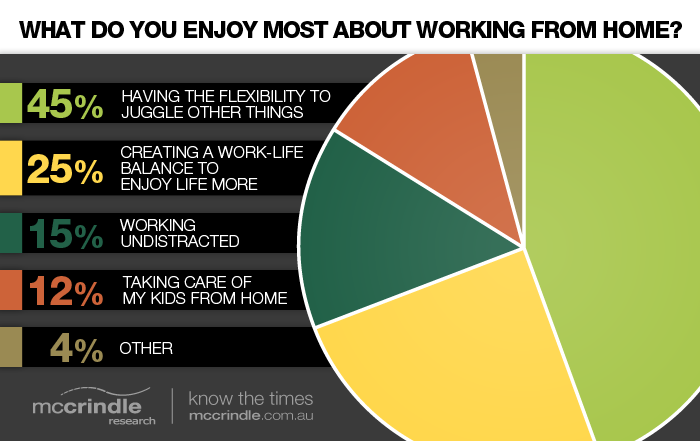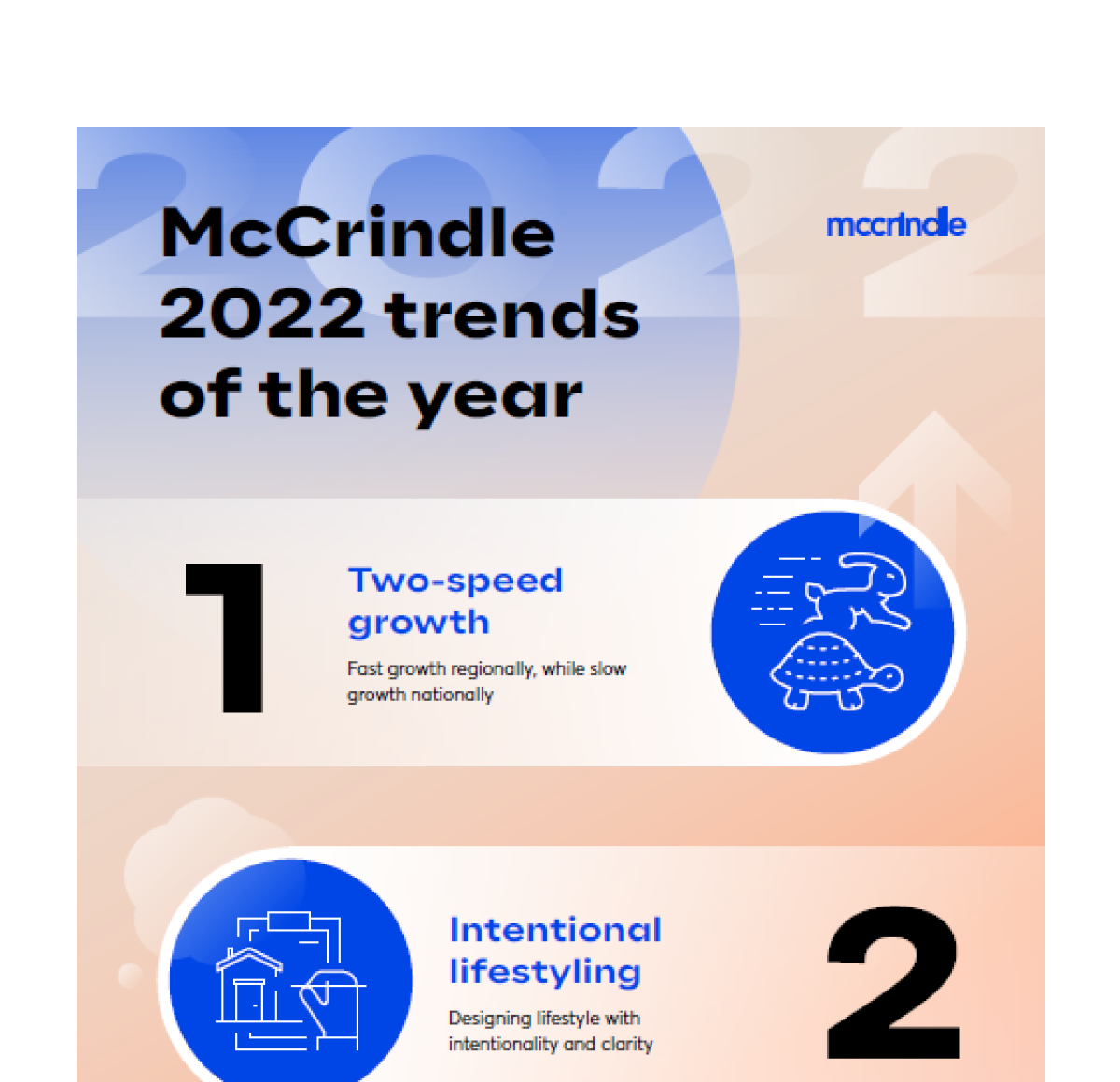Working from home: The benefits and the cost

Working from home is a key employment alternative for growing businesses offering teleworking solutions, emerging entrepreneurs establishing a customer base, and small business owners seeking to minimise administrative overheads.
What are the key advantages and setbacks involved with working from home? For those seeking to take the plunge or weighing up the options, McCrindle Research has recently analysed the lives of 250 ‘work-from-home’ workers, weighing up the pros and cons of the home office setting.

Click here to download the full research summary.
Key enjoyment factors: Flexibility and work-life balance
The most significant advantage in working from home for respondents was having the flexibility to juggle other things, reported by almost half (45%) or respondents. Another quarter of respondents felt that in working from home, they were able to create a work-life balance to enjoy life more. 1 in 7 respondents (15%) enjoyed being able to work undistracted from the interruptions present in an office-based working environment, and a further 1 in 8 (12%) felt that the most significant advantage in working from home was being able to take care of their children.
Other reasons that people chose to work from home included decreased commuter stress, lower travel costs, being able to work in solitude, and being their own boss.
“While those who work from home most love the flexibility and work-life balance that it allows,” says social researcher Mark McCrindle, “For 15%, the biggest benefit was being able to work undistracted. Employers should note that while modern workplaces facilitate social interaction, project teams and meetings, the need to work solo and uninterrupted is keenly felt.
Key advantages explored: Flexibility, decreased commuter stress, increased time with family
When explaining these significant advantages and others in working at home instead of an office based environment, participants elaborated on a number of key themes:
Flexibility in working hours was seen as a key advantage:
“The ability to work all hours and unusual hours, doing other non-work things in the home.”
“The flexibility to work when I can, choosing when I work.”
Having less stress due to commuting to and from work was mentioned numerously:
“Less time spent travelling means I have more time to devote to chores and exercise.”
“I don’t have to deal with traffic congestion and save travel time.”
Spending time with family was seen by others as a great positive:
“I can work around family and other commitments, and am able to take more part in raising my son.”
“I work when I want and have more time with my family, and I can eat lunch at home while seeing
my wife and kids.”
The need for social interaction while working from home
When asked to comment on the difference in social interaction between working in an office-based working environment and working from home, 3 out of 5 respondents (58%) noted that they feel some need for increased social interaction.
While working from home does create the difficulties of social isolation for almost 3 in 5 home-workers, 42% never feel this deficiency: “Even when discussing this lack of interaction it was more in a professional, collegiate sense than a purely social sense. This research highlights that the best workplaces are those that provide the opportunities for collaboration and professional interactions, while ensuring that private work spaces are provided. Employers need to think like an extrovert and an introvert in their workspace provisions,” says McCrindle.
Greatest disadvantages: Isolation, distractions and work-life balance
Respondents were asked to name the most significant disadvantage they face in working from home through an open-ended response.
The biggest negative that workers faced in working from home, reported by 22% of respondents, was professional and social isolation:
“Working on my own and only seeing friends and workmates occasionally.”
“Not having other employees to sound ideas and brainstorm with.”
“I am isolated and lonely at times, and do less networking.”
Maintaining a work-life balance was the most significant difficulty according to 15% of respondents:
“[There are] no boundaries between home and work life.”
“[I] can’t relax because I know there is work to do. It’s hard to stop.”
“Being on call – people seem to think you are available at any time, including your days off.”
Household distractions were another common thread, reported as most significant by 14% of respondents:
“[I am] too easily distracted by household tasks.”
“[I find it difficult] to get into the mindset of ‘working’ at home without distractions.”
“The environment is not conducive to working.”
Other common issues included the access and cost of necessary resources (8%) such as documents and technology, the perception that work from home is not actually work (7%), self-motivation (6%), lower income received (4%) when working from home, and poor communication between home and the office (3%).
“I am unable to access other files and lack access to computer systems.”
“The expense of technology and using more utilities (electricity, internet cost, gas for
heating, water).”
“I am trying to justify that I am actually working; the perception by others is that I’m not.”
“[I lack the] motivation to start each day that I work.”
“My income is lower now that I’m working at home.”
“I’m not finding out what has happened during work.”
Still others (1 in 5, 21%) reported no negative experiences with working from home:
“I have really enjoyed [working from home] and think it is the way of the future.”
“I can’t do it often enough – I have found no negatives.”
“There has been no negative for me personally working from home. If anything, I am far more
productive due to less distraction.”
Unexpected costs: office supplies, electricity bills, and household consumption
While over half of respondents (52%) who had worked from home had never incurred any unexpected costs in doing so, the other half of respondents had. 1 in 3 (30%) respondents spent more on office supplies and technology than working in an office environment, 1 in 4 (25%) had incurred higher electricity bills, and 1 in 6 (16%) noticed an increase in food consumption and home goods.
Workplace health and safety issues
While a number of respondents (75%) did not report encountering any workplace health and safety (WHS) issues in working in a home office environment, others were faced with unique concerns:
The main concern respondents faced was with lack of ergonomics in their home office set-up:
“I generally don’t sit at a proper desk so, while not currently causing any problems,
my posture may cause issues in the future.”
“I don’t have proper desk and chair height, and I stay at the desk too long with bad posture.”
Others felt the weight of responsibility when it came to WHS issues:
“I am totally responsible for the health and safety standards and issues in my home, even when
someone comes uninvited.”
Still others reported not taking appropriate breaks as an issue:
“I don’t take appropriate breaks and I lack sleep, working longer than I would in an office.”
The lack of space and unsuitability of the home working environment were other issues:
“I don’t have enough space to work properly.”
“The electrics in the house are not always the best set-up because I don’t have an office, and
the kids can get under the desk playing with cables.”
“With teleworking a growing phenomenon and working from home a key tool of workplace retention, managers not only need to provide for it, but also effectively manage it,” says McCrindle. “This research reveals challenges along with the benefits, with almost half of Australians who work from home incurring some increased costs, and one in four experiencing some workplace health and safety issues.”
Click here to download the full research summary.
For media commentary contact us on 02 8824 3422 or at [email protected]




